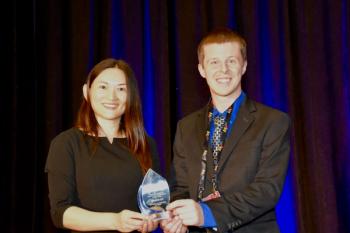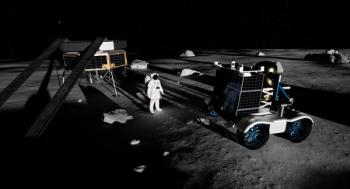
Vicki H. Grassian Wins Pittsburgh Spectroscopy Award
This award is given annually to a researcher who has demonstrated outstanding achievements in the field of spectroscopy.
On February 26, Sunil Saxena from the University of Pittsburgh presented The Pittsburgh Spectroscopy Award to Vicki H. Grassian a distinguished professor and distinguished chair in Physical Chemistry in the Department of Chemistry & Biochemistry at UC San Diego. The Pittsburgh Spectroscopy Award, established in 1957, is given annually to a researcher who has demonstrated outstanding achievements in the field of spectroscopy. The theme of this year’s award session was environmental analysis using spectroscopic techniques.
Grassian presented “Spectroscopy as a Probe of the Chemistry and Impacts of Environmental Interfaces.” This award address focused on using infrared spectroscopy as a probe of the chemistry, as well as the impacts, of environmental interfaces. Environmental interfaces are defined as any surface in equilibrium with its surrounding environment. From this broad definition, there are a myriad of different types of environmental interfaces that include atmospheric aerosols, aqueous microdroplets, engineered and geochemical nanomaterials and indoor surfaces. The chemistry of environmental interfaces puts a focus on the molecular and nanoscale level interactions that occur in these inherently complex systems. A broad array of different spectroscopic techniques were discussed that can provide insights into these interfaces. Grassian’s group focuses on the chemistry and impacts of environmental interfaces as they relate to atmospheric aerosols, engineered and geochemical nanomaterials, and indoor surfaces. She has developed and utilized many different spectroscopic techniques to probe the chemistry and impacts of environmental interfaces throughout her career.
Veronica Vaida of the University of Colorado at Boulder presented her work using infrared spectroscopy, “Spectroscopy of Organics at Water-air Interfaces Relevant to Environmental Systems.” Inspired by atmospheric measurements, which have established that atmospheric chemistry occurs in many phases and at interfaces, Vaida’s research has explored the unique reaction environments presented by planetary atmospheres using surface reflection spectroscopies. Specifically infrared reflection absorption spectroscopy (IRRAS) and ultraviolet resonance Raman spectroscopy (UVRES) methods were described along with results for chemical and photochemical experiments at the water surface. The special morphological and chemical properties of organic films on aqueous solutions was discussed with reference to atmospheric aerosols, sea surface microlayers, and cloud and fog droplets.
Kimberly Prather a Distinguished Professor at UC San Diego presented her work in mass spectrometry entitled, “Wind/wave Laboratory Studies of the Impacts of the Ocean on Atmospheric Chemistry, Health, and Climate.” During a period of change on Earth, enhancing our comprehension of the ocean/atmosphere system's influence on climate is essential. Prather’ work assesses the effects of ocean microbes on the atmosphere, especially their feedback mechanisms affecting cloud formation, health, and climate. This presentation elucidated findings from novel ocean/atmosphere laboratory experiments with a significant emphasis on understanding the factors that govern the composition, cloud formation capabilities, and ice nucleation properties of marine aerosols in coastal environments.
Andrew Ault of the University of Michigan presented his research using Raman spectroscopy (SERS) entitled, “Vibrational Spectroscopy Insights Into Multiphase Chemistry and Evolution of Atmospheric Aerosols.” To study atmospheric aerosols, Ault’s research focuses on the application of vibrational spectroscopy to studying aerosol systems. Analytical techniques used include atomic force microscopy coupled with photothermal infrared spectroscopy (AFM-PTIR) and optical photothermal infrared spectroscopy (O-PTIR) coupled with simultaneous Raman microspectroscopy.
The final presentation of this session focused on the application of infrared spectroscopy. The talk was presented by Jahan Dawlaty of the University of Southern California. His presentation was titled, “Using Vibrational Probes for Revealing the Complexities of Interfacial Environments.” Dawlaty reported the use of vibrational Stark shift spectroscopy in surface science and electrochemistry applications to measure an array of complex samples. These sample types included studies of the interface between electrodes and solvents, surfactants, and ionic liquids to improve our understanding of such systems.
Newsletter
Get essential updates on the latest spectroscopy technologies, regulatory standards, and best practices—subscribe today to Spectroscopy.




